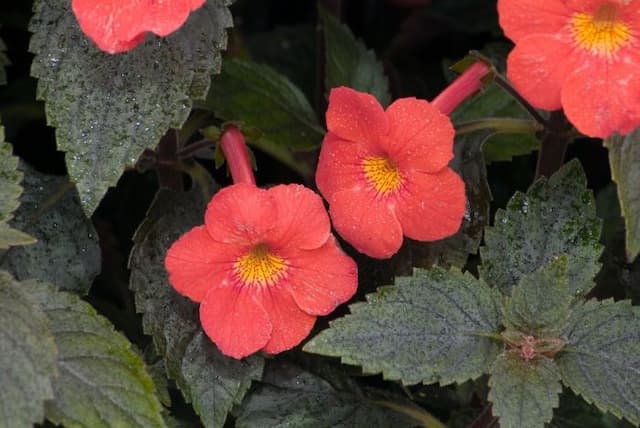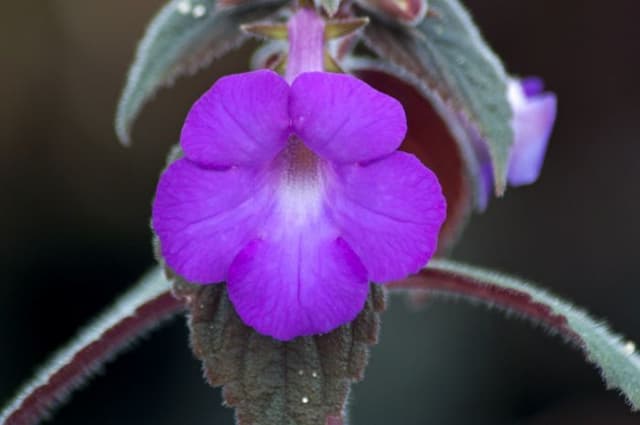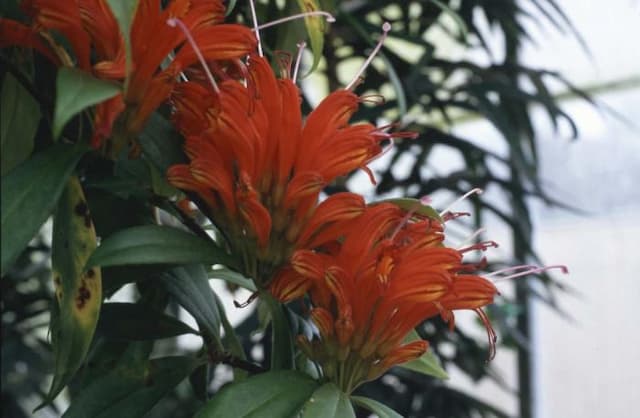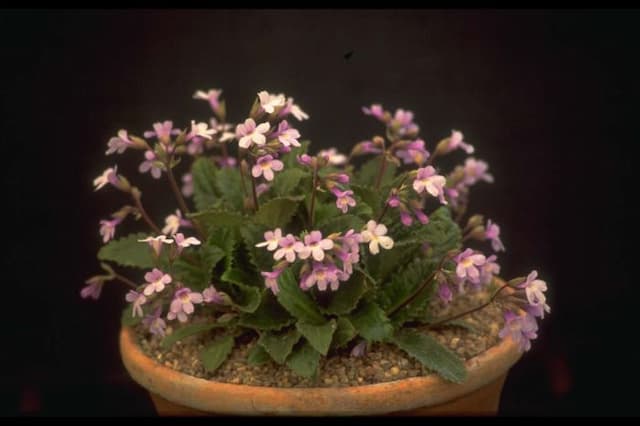Brazilian Edelweiss Sinningia conspicua

ABOUT
Sinningia conspicua, often referred to by its common name, the "Gloxinia," is a Brazilian species with a remarkable appearance that adds exotic flair to any collection. This eye-catching plant displays a rosette of fuzzy, ovate leaves that are typically dark green and can have a velvety texture. The leaves may sometimes show a lighter green or silvery hue along the veins. The Gloxinia is particularly admired for its large trumpet-shaped flowers, which boast an impressive show of colors. These blooms can vary in color but are often found in shades of white, pink, red, or purple, with some having contrasting edges or throats that make the flowers even more striking. The appearance of delicate dots or speckles is also common within the throat of the flowers, adding to their ornamental beauty. The flowers arise on short individual stems, emerging from the foliage to proudly display their full glory. The overall form of the Gloxinia is compact, with its most distinctive features being the plush foliage and the spectacular, almost oversized blossoms that can sometimes dwarf the leaves in their prominence. The combination of its soft leaf texture and the velvety allure of its blooms makes the Gloxinia a popular choice for indoor plant enthusiasts seeking a touch of tropical elegance.
About this plant
 Names
NamesFamily
Gesneriaceae
Synonyms
Brazilian Edelweiss, Showy Sinningia
Common names
Rechsteineria conspicua.
 Toxicity
ToxicityTo humans
Sinningia conspicua, commonly known as the "Showy Sinningia," is not widely known to be toxic to humans. There is limited information available on the specific toxicity of this plant to humans, and it does not appear on most lists of poisonous plants. However, as with any plant, individual sensitivities and allergic reactions are possible. In general, it's advisable to avoid ingesting any part of ornamental plants due to potential unknown toxicities.
To pets
Showy Sinningia is not typically listed as toxic to pets, including cats and dogs. There is a lack of data on the specific effects of Sinningia conspicua on pets, but it is not commonly recognized as a plant that is harmful to animals. Nonetheless, it is prudent to prevent pets from ingesting this or any ornamental plant, as they may cause gastrointestinal upset or other issues in pets sensitive to them. If you suspect your pet has ingested this plant and is showing symptoms of illness, it is recommended to consult a veterinarian.
 Characteristics
CharacteristicsLife cycle
Perennials
Foliage type
Deciduous
Color of leaves
Green
Flower color
White
Height
1 foot (30 cm)
Spread
1 foot (30 cm)
Plant type
Bulb
Hardiness zones
10
Native area
Brazil
Benefits
 General Benefits
General Benefits- Aesthetic Appeal: Sinningia conspicua, commonly known as the large-flowered sinningia, produces striking white to pale pink flowers that enhance the visual attractiveness of gardens and indoor spaces.
- Low Maintenance: This plant is relatively easy to care for, requiring minimal upkeep once established, making it suitable for novice gardeners.
- Pest Resistance: The large-flowered sinningia is known to have some resistance to common pests, reducing the need for chemical pest control.
- Drought Tolerance: Adapted to survive with less water, Sinningia conspicua can thrive in drier conditions once established, making it ideal for water-conservative gardening.
- Container Gardening: Due to its compact size, it is a suitable plant for container gardening, allowing for versatility in placement and easy rearrangement.
- Seasonal Interest: Having a specific blooming season, Sinningia conspicua adds seasonal interest to gardens, often blooming profusely in the spring or summer.
- Attracts Pollinators: Its flowers can attract pollinators such as hummingbirds and butterflies, promoting biodiversity in the garden environment.
 Medical Properties
Medical PropertiesThis plant is not used for medical purposes.
 Air-purifying Qualities
Air-purifying QualitiesThis plant is not specifically known for air purifying qualities.
 Other Uses
Other Uses- Sinningia conspicua tubers can be studied as a source of starch for crafting biodegradable plastics, due to their high starch content.
- The plant's vibrant blooms make it an excellent candidate for botanical art subjects, inspiring artists to capture its beauty on canvas or paper.
- In educational settings, Sinningia conspicua is used to teach botany students about tuberous plant species and their growth patterns.
- The large flowers and structural characteristics of the plant serve as interesting subjects for photography enthusiasts and professionals.
- The thick leaves of the Sinningia conspicua can be examined for their texture and structure in plant morphology studies.
- Its role in hybridization research is valuable, as it can be crossed with other Sinningia species to produce new ornamental varieties.
- The aesthetic appeal of Sinningia conspicua makes it a fine addition to themed gardens, such as Victorian or tropical-themed landscapes.
- The plant can be used in tabletop gardening, providing an attractive centerpiece for indoor decoration due to its lush foliage and striking flowers.
- Because of its adaptability to various soil types, Sinningia conspicua is ideal for erosion control in gardens and landscaping.
- The Sinningia conspicua plant is sometimes used in permaculture designs as a perennial that can provide seasonal interest without the need for replanting each year.
Interesting Facts
 Feng Shui
Feng ShuiThe Brazilian Edelweiss is not used in Feng Shui practice.
 Zodiac Sign Compitability
Zodiac Sign CompitabilityThe Brazilian Edelweiss is not used in astrology practice.
 Plant Symbolism
Plant Symbolism- Charm and Attraction: With its striking blooms, Sinningia conspicua, commonly known as the "Gloxinia", symbolizes natural beauty that draws attention and admiration.
- Wealth and Opulence: The rich and velvety appearance of Gloxinia's flowers often represents abundance and prosperity.
- Passion and Love: The intense colors and enchanting scent of the Gloxinia can denote deep love and strong passion.
- Resilience and Recovery: As a plant that can regrow from its tubers after a period of dormancy, Gloxinia symbolizes the ability to recover from challenges and hardships.
- Pride and Confidence: The upright stance and confidence of the Gloxinia's blooms can be a symbol of self-assuredness and pride.
 Water
WaterFor the Brazilian Edelweiss (Sinningia conspicua), water thoroughly until water drains out of the bottom, but allow the soil to dry out between waterings. Typically, watering once a week suffices, but during the growing season in spring and summer, you may need to water more frequently, like every 5 days. Decrease watering in the fall and winter when the plant is dormant. When watering, use roughly 8-16 ounces of water depending on the size of the pot and the dryness of the soil, ensuring not to leave the plant in standing water to avoid root rot.
 Light
LightBrazilian Edelweiss (Sinningia conspicua) thrives best in bright, indirect light. It should not be placed in direct sunlight, which could scorch the leaves. An ideal spot would be a few feet away from a sunny window or in a well-lit room where natural light is diffused by sheer curtains or blinds.
 Temperature
TemperatureBrazilian Edelweiss (Sinningia conspicua) prefers temperatures between 60 and 75 degrees Fahrenheit. It can survive minimum temperatures of about 50 degrees Fahrenheit, making it unsuitable for cold, drafty locations. Keep it away from extreme heat sources and air conditioning vents that could cause fluctuating temperatures and stress the plant.
 Pruning
PruningPrune Brazilian Edelweiss (Sinningia conspicua) to remove any dead or yellowing leaves and to shape the plant for a more compact growth habit. Pruning is best done after flowering or during the plant's active growth period in spring or early summer. Do not prune more than one-third of the plant at a time to avoid causing stress. Pruning will encourage new growth and maintain a healthy plant appearance.
 Cleaning
CleaningAs needed
 Soil
SoilFor the Brazilian Edelweiss (Sinningia conspicua), prepare a soil mix that is well-draining and porous; a combination of peat, perlite, and loam is ideal. An acidic to slightly acidic pH of 5.5 to 6.5 is optimal for healthy plant growth.
 Repotting
RepottingBrazilian Edelweiss should generally be repotted every 1-2 years or when it becomes rootbound. Spring or early summer is the best time for repotting to allow the plant to adjust to the new container.
 Humidity & Misting
Humidity & MistingBrazilian Edelweiss prefers moderate to high humidity levels, around 50-60%. Consistently high humidity without overwatering helps to mimic its natural environment.
 Suitable locations
Suitable locationsIndoor
Place near a window, avoid direct sun, keep soil moist, high humidity.
Outdoor
Provide partial shade, shelter from strong winds, moderate watering.
Hardiness zone
10-11 USDA
 Life cycle
Life cycleSinningia conspicua, commonly known as the "Gloxinia," begins its life cycle as a seed, which germinates in warm, moist soil conditions. Upon sprouting, it develops into a small seedling with a rosette of leaves, through which it undergoes vegetative growth. The plant will then mature and enter the flowering stage, where it produces large, bell-shaped white flowers that attract pollinators. Following pollination, the gloxinia sets seed, which will eventually disperse to give rise to new plants. Outside of cultivation, these seeds may lie dormant until conditions are favorable for germination. After flowering, the plant may enter a period of dormancy, especially in cooler climates, where the above-ground structure dies back and the tuberous root remains dormant until the next growing season.
 Propogation
PropogationPropogation time
Spring to Summer
For the Sinningia conspicua, also known as the showy sinningia, the most popular method of propagation is through tuber division, typically performed in late winter or early spring before the plant begins active growth. To propagate by dividing the tubers, carefully unearth the mother plant and gently separate the tubers, ensuring that each division has at least one growth bud. The divisions can then be potted individually in a well-draining potting mix, ideally containing a mixture of peat, perlite, and sand to provide the aeration and drainage that the sinningia prefers. Water the newly potted tubers sparingly until new growth appears, indicating that they have successfully established roots. Once the plants start to grow, resume regular watering and care as you would for a mature Sinningia conspicua.









